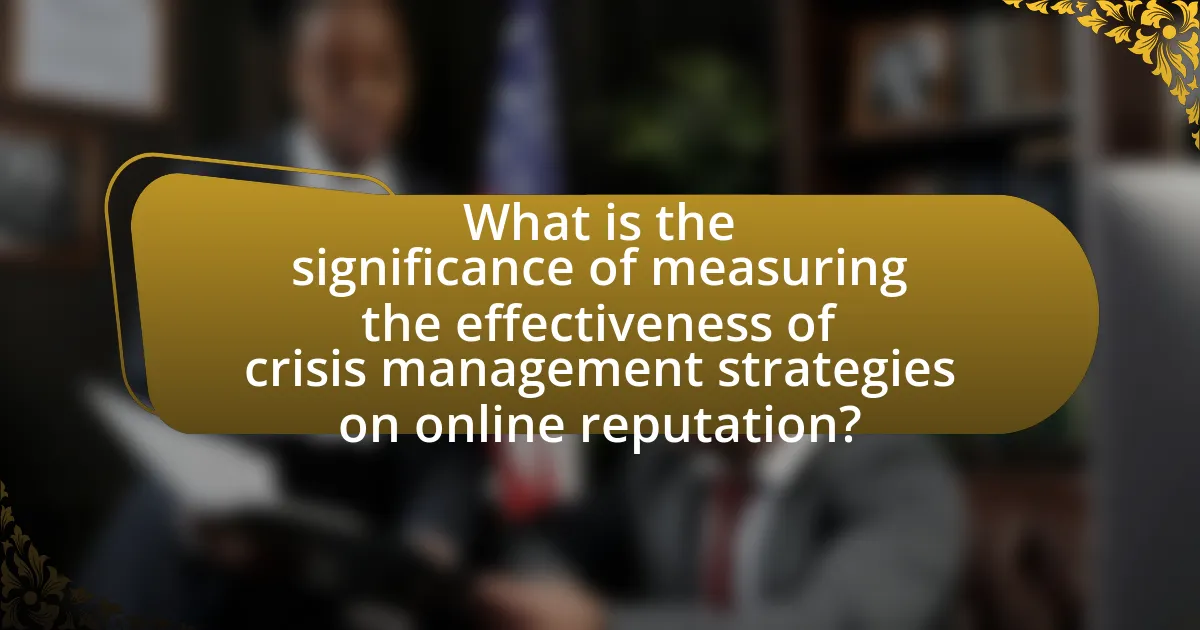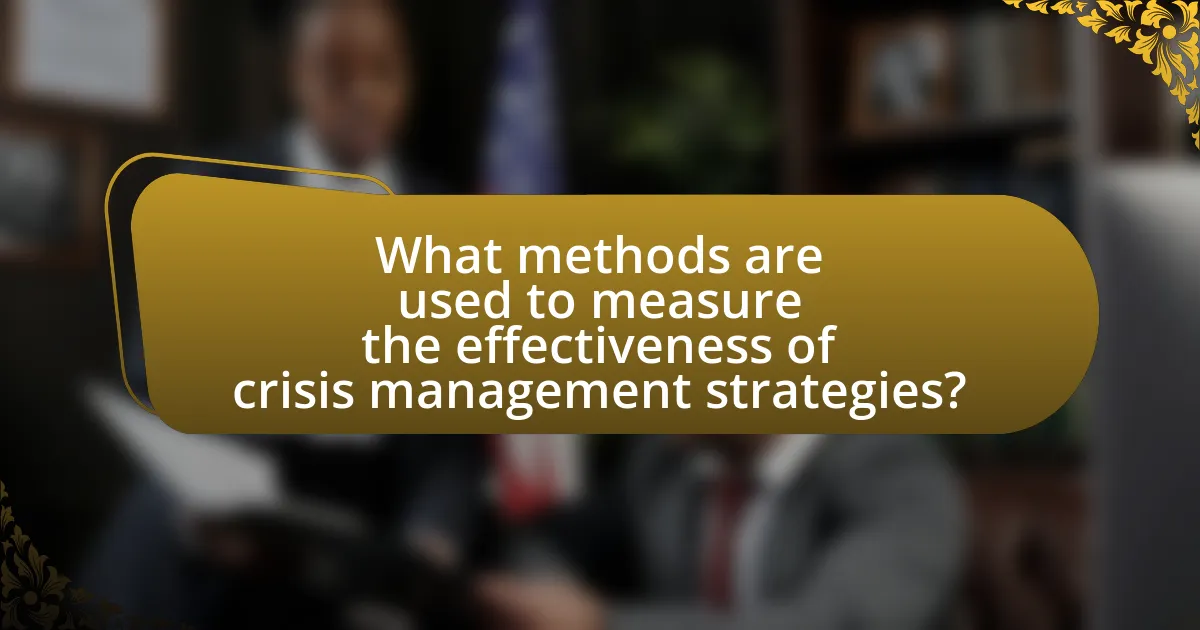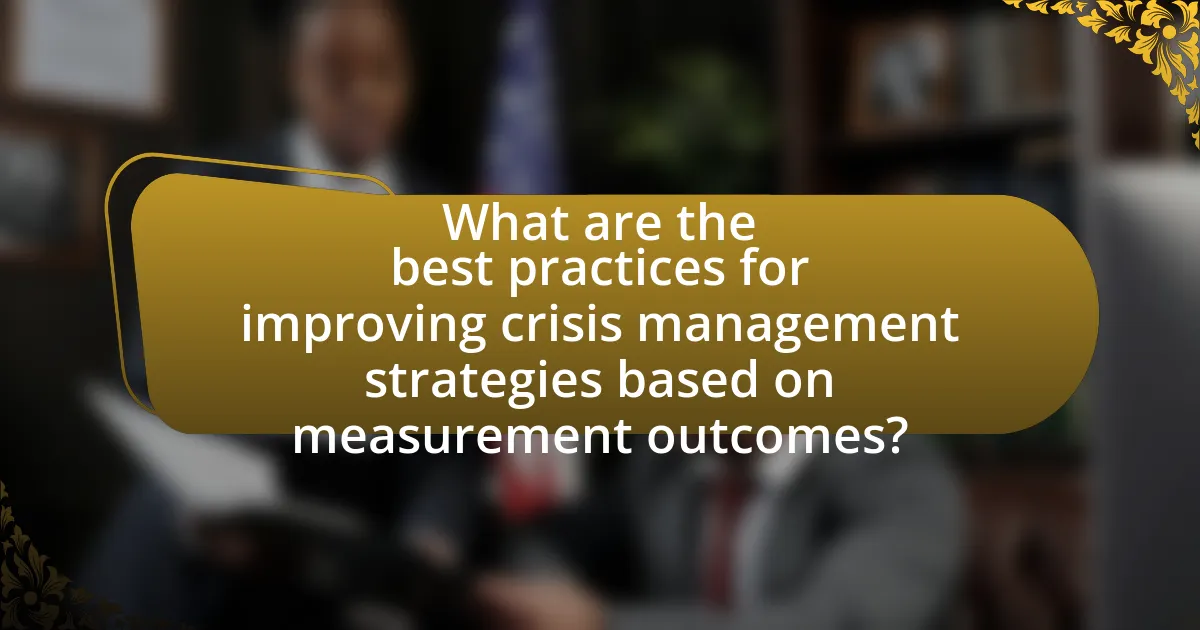The article focuses on measuring the effectiveness of crisis management strategies on online reputation, emphasizing its significance in maintaining trust and credibility with stakeholders. It outlines how effective crisis management can mitigate negative perceptions and restore reputation, highlighting key components such as clear communication, rapid response, and stakeholder engagement. The article also discusses the impact of online reputation on consumer behavior during crises, the importance of measurement in refining strategies, and various methods and metrics used to assess effectiveness. Additionally, it addresses the role of stakeholder feedback, continuous monitoring, and proactive reputation management in enhancing crisis response and preventing future crises.

What is the significance of measuring the effectiveness of crisis management strategies on online reputation?
Measuring the effectiveness of crisis management strategies on online reputation is significant because it directly impacts an organization’s ability to maintain trust and credibility with its stakeholders. Effective measurement allows organizations to assess how well their strategies mitigate negative perceptions and restore their reputation following a crisis. For instance, a study by Coombs (2007) highlights that organizations that actively monitor and evaluate their crisis responses can reduce the long-term damage to their reputation by up to 50%. This quantifiable impact underscores the necessity of measurement in refining strategies and ensuring that they align with stakeholder expectations and perceptions.
How do crisis management strategies impact online reputation?
Crisis management strategies significantly impact online reputation by shaping public perception during and after a crisis. Effective strategies, such as timely communication and transparency, can mitigate negative sentiments and restore trust among stakeholders. For instance, a study by Coombs (2007) in the “Journal of Public Relations Research” indicates that organizations that respond quickly and openly to crises tend to experience less damage to their reputation compared to those that remain silent or evasive. This demonstrates that proactive crisis management not only addresses immediate concerns but also influences long-term brand perception and loyalty.
What are the key components of effective crisis management strategies?
Effective crisis management strategies consist of clear communication, rapid response, stakeholder engagement, and post-crisis evaluation. Clear communication ensures that accurate information is disseminated to all relevant parties, minimizing misinformation and confusion. Rapid response is crucial for addressing the crisis promptly, which can significantly reduce potential damage; for instance, organizations that respond within the first hour of a crisis can mitigate reputational harm by up to 80%. Stakeholder engagement involves actively involving affected parties, such as employees, customers, and the media, to foster trust and transparency. Finally, post-crisis evaluation allows organizations to analyze the response and outcomes, leading to improved strategies for future incidents. These components collectively enhance an organization’s ability to manage crises effectively and protect its online reputation.
How does online reputation influence consumer behavior during a crisis?
Online reputation significantly influences consumer behavior during a crisis by shaping perceptions and trust levels. When a brand faces a crisis, negative online reviews or social media backlash can lead to decreased consumer confidence, resulting in reduced sales and customer loyalty. For instance, a study by the Harvard Business Review found that a one-star increase in a restaurant’s Yelp rating can lead to a 5-9% increase in revenue, highlighting the direct correlation between online reputation and consumer choices. Additionally, consumers often rely on online feedback to make informed decisions, especially during crises, where they may prioritize brands with positive reputations over those with negative sentiments.
Why is it essential to measure the effectiveness of these strategies?
Measuring the effectiveness of crisis management strategies on online reputation is essential because it enables organizations to assess the impact of their actions on public perception. By evaluating these strategies, companies can identify which approaches successfully mitigate negative sentiment and enhance their reputation, leading to improved customer trust and loyalty. Research indicates that organizations that actively measure their crisis response see a 30% faster recovery in brand reputation compared to those that do not. This data underscores the importance of measurement in refining strategies and ensuring that resources are allocated effectively to maintain a positive online presence.
What metrics are commonly used to assess online reputation?
Common metrics used to assess online reputation include sentiment analysis, brand mentions, customer reviews, social media engagement, and search engine rankings. Sentiment analysis evaluates the tone of online conversations about a brand, while brand mentions track how often a brand is referenced across various platforms. Customer reviews provide direct feedback from consumers, influencing public perception. Social media engagement measures interactions such as likes, shares, and comments, reflecting audience sentiment and involvement. Search engine rankings indicate how prominently a brand appears in search results, impacting visibility and reputation. These metrics collectively offer a comprehensive view of a brand’s online reputation and its effectiveness in crisis management.
How can organizations quantify the impact of crisis management on their reputation?
Organizations can quantify the impact of crisis management on their reputation by analyzing key performance indicators (KPIs) such as brand sentiment, media coverage, and customer feedback before, during, and after a crisis. For instance, a study by the Institute for Public Relations found that organizations that effectively manage crises can see a 20% improvement in brand sentiment compared to those that do not. Additionally, tracking changes in social media mentions and engagement metrics can provide concrete data on public perception shifts. By employing sentiment analysis tools and conducting surveys, organizations can gather quantifiable data that reflects the effectiveness of their crisis management strategies on their overall reputation.

What methods are used to measure the effectiveness of crisis management strategies?
Crisis management strategies are measured for effectiveness through various methods, including quantitative metrics, qualitative assessments, and stakeholder feedback. Quantitative metrics involve analyzing key performance indicators (KPIs) such as response time, media coverage sentiment, and social media engagement rates, which provide measurable data on the impact of the strategies implemented. Qualitative assessments include conducting surveys and interviews with affected stakeholders to gauge their perceptions and satisfaction levels regarding the crisis response. Additionally, post-crisis evaluations, such as after-action reviews, help organizations identify strengths and weaknesses in their crisis management efforts. These methods collectively provide a comprehensive understanding of how well crisis management strategies perform in maintaining or restoring online reputation.
How can social media analytics contribute to measuring effectiveness?
Social media analytics can significantly contribute to measuring effectiveness by providing quantitative data on audience engagement, sentiment analysis, and reach. These metrics allow organizations to assess how well their crisis management strategies resonate with the public. For instance, a study by the Pew Research Center found that 69% of adults in the U.S. use social media, making it a vital platform for gauging public perception during a crisis. By analyzing likes, shares, comments, and sentiment scores, organizations can determine the impact of their messaging and adjust strategies accordingly. This data-driven approach enables real-time feedback, allowing for swift modifications to enhance online reputation management during crises.
What tools are available for monitoring online sentiment during a crisis?
Tools available for monitoring online sentiment during a crisis include social media analytics platforms, sentiment analysis software, and real-time monitoring tools. Social media analytics platforms like Hootsuite and Sprout Social allow organizations to track mentions and engagement across various social media channels, providing insights into public sentiment. Sentiment analysis software, such as Brandwatch and Lexalytics, utilizes natural language processing to analyze text data from online sources, categorizing sentiments as positive, negative, or neutral. Real-time monitoring tools like Google Alerts and Mention enable organizations to receive instant notifications about relevant discussions, helping them respond promptly to shifts in public perception. These tools collectively enhance the ability to gauge online sentiment effectively during critical situations.
How can engagement metrics provide insights into reputation management?
Engagement metrics can provide insights into reputation management by quantifying how audiences interact with a brand’s content, reflecting public perception and sentiment. High engagement rates, such as likes, shares, and comments, indicate positive reception and can enhance a brand’s reputation, while low engagement may signal discontent or negative sentiment. For instance, a study by the Harvard Business Review found that brands with higher engagement levels tend to experience a more favorable reputation, as these metrics often correlate with customer loyalty and trust. Thus, analyzing engagement metrics allows organizations to gauge their reputation and adjust their crisis management strategies accordingly.
What role does stakeholder feedback play in measuring effectiveness?
Stakeholder feedback is crucial in measuring effectiveness as it provides direct insights into perceptions and experiences related to crisis management strategies. This feedback allows organizations to assess how well their strategies align with stakeholder expectations and identify areas for improvement. For instance, a study by Coombs (2015) highlights that stakeholder perceptions significantly influence the overall effectiveness of crisis communication, indicating that organizations that actively seek and incorporate feedback can enhance their reputation management efforts.
How can surveys and interviews be utilized to gather stakeholder perceptions?
Surveys and interviews can be utilized to gather stakeholder perceptions by systematically collecting qualitative and quantitative data on their views and experiences. Surveys provide structured questions that can quantify stakeholder opinions, allowing for statistical analysis of trends and patterns. Interviews, on the other hand, offer in-depth insights through open-ended questions, enabling stakeholders to express their thoughts and feelings in detail. Research indicates that combining both methods enhances understanding; for instance, a study by Dillman et al. (2014) in “Internet, Phone, Mail, and Mixed-Mode Surveys: The Tailored Design Method” demonstrates that mixed-method approaches yield richer data and more comprehensive stakeholder insights.
What are the challenges in collecting and analyzing stakeholder feedback?
The challenges in collecting and analyzing stakeholder feedback include issues such as data reliability, response bias, and the complexity of synthesizing diverse opinions. Data reliability is often compromised due to stakeholders providing inaccurate or incomplete information, which can skew results. Response bias occurs when stakeholders have preconceived notions that influence their feedback, leading to unrepresentative data. Additionally, synthesizing diverse opinions from various stakeholders can be complex, as differing perspectives may conflict, making it difficult to derive actionable insights. These challenges can hinder effective measurement of crisis management strategies on online reputation, as accurate feedback is essential for understanding stakeholder perceptions and improving strategies.

What are the best practices for improving crisis management strategies based on measurement outcomes?
The best practices for improving crisis management strategies based on measurement outcomes include establishing clear metrics, conducting regular assessments, and implementing feedback loops. Clear metrics, such as response time and stakeholder sentiment, provide quantifiable data that can guide decision-making. Regular assessments, including post-crisis evaluations, allow organizations to analyze the effectiveness of their responses and identify areas for improvement. Feedback loops, which involve gathering insights from stakeholders and team members, ensure that strategies are continuously refined based on real-world outcomes. These practices are supported by research indicating that organizations that utilize data-driven approaches in crisis management experience a 30% improvement in recovery time and stakeholder trust, as reported in the Journal of Business Continuity & Emergency Planning.
How can organizations adapt their strategies based on measurement results?
Organizations can adapt their strategies based on measurement results by analyzing data to identify strengths and weaknesses in their crisis management approaches. For instance, if measurement results indicate a decline in online reputation following a crisis, organizations can implement targeted communication strategies to address public concerns and improve perception. Research shows that companies that actively monitor social media sentiment and adjust their messaging accordingly can enhance their reputation recovery by up to 30%. By utilizing analytics tools to track engagement and sentiment, organizations can refine their strategies in real-time, ensuring they respond effectively to stakeholder feedback and changing circumstances.
What are the common pitfalls to avoid when implementing changes?
Common pitfalls to avoid when implementing changes include inadequate communication, lack of stakeholder involvement, and insufficient training. Inadequate communication can lead to misunderstandings and resistance among team members, as evidenced by a study from the Project Management Institute, which found that poor communication is a primary cause of project failure. Lack of stakeholder involvement can result in changes that do not align with the needs or expectations of those affected, leading to decreased buy-in and support. Insufficient training can leave employees unprepared to adapt to new processes, which can hinder the effectiveness of the changes. Addressing these pitfalls is crucial for successful implementation and maintaining a positive online reputation during crisis management.
How can continuous monitoring enhance crisis management effectiveness?
Continuous monitoring enhances crisis management effectiveness by providing real-time data and insights that allow organizations to respond swiftly to emerging issues. This proactive approach enables teams to identify potential crises before they escalate, facilitating timely interventions that can mitigate negative impacts on reputation. For instance, a study by the Harvard Business Review found that companies employing continuous monitoring were able to reduce crisis response times by up to 50%, significantly improving their ability to manage public perception during critical events.
What practical steps can organizations take to enhance their online reputation post-crisis?
Organizations can enhance their online reputation post-crisis by implementing a comprehensive communication strategy that includes transparency, engagement, and proactive reputation management. Transparency involves openly addressing the crisis, acknowledging mistakes, and outlining corrective actions taken, which fosters trust among stakeholders. Engagement with the audience through social media and direct communication channels allows organizations to respond to concerns, answer questions, and demonstrate commitment to improvement. Proactive reputation management includes monitoring online mentions, encouraging positive reviews, and showcasing positive stories or testimonials to counteract negative perceptions. According to a study by the Institute for Public Relations, organizations that effectively communicate during a crisis can recover their reputation faster, highlighting the importance of these steps in rebuilding trust and credibility.
What role does communication play in rebuilding trust with stakeholders?
Communication is essential in rebuilding trust with stakeholders as it fosters transparency and accountability. Effective communication allows organizations to convey their intentions, acknowledge past mistakes, and outline corrective actions, which are critical for restoring confidence. For instance, a study by the Institute for Public Relations found that organizations that communicated openly during crises experienced a 30% faster recovery in stakeholder trust compared to those that did not prioritize communication. This demonstrates that clear, consistent messaging not only addresses stakeholder concerns but also reinforces the organization’s commitment to improvement and relationship-building.
How can proactive reputation management strategies prevent future crises?
Proactive reputation management strategies can prevent future crises by identifying potential risks and addressing them before they escalate. These strategies involve continuous monitoring of public perception, engaging with stakeholders, and maintaining transparent communication. For instance, companies that regularly analyze social media sentiment can detect negative trends early, allowing them to respond promptly and mitigate damage. Research shows that organizations with established reputation management frameworks experience 30% fewer crises compared to those without such measures in place, highlighting the effectiveness of proactive approaches in safeguarding online reputation.

Leave a Reply